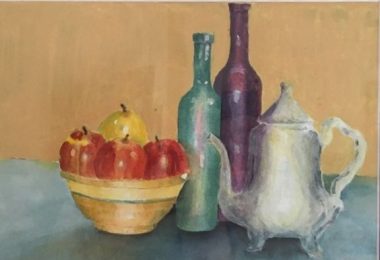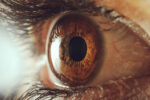Let’s Open the Door to Creativity

Living with Parkinson’s disease (PD) has been a curse and a blessing. The curse is a progressive chronic illness, and the blessing is being able to write creatively about the experience in a way that helps others.
Writing for Parkinson’s News Today provides worthiness, pleasure, and self-expression for me. It’s the reason I call my column “Possibilities with Parkinson’s” and my book “Possibilities with Parkinson’s: A Fresh Look.” There are always possibilities no matter what life throws at us.
My creative tendencies reach far back into my early years. Throughout those years, garden landscaping, rockhounding, graphic arts, and writing all gave me a great deal of pleasure and a sense of accomplishment. Sadly, some of these interests have been curtailed by PD and my vision loss.
On the bright side, I have developed strategies to overcome some of the disability limitations, allowing me to continue many creative interests. Staying creative is a big part of living well with PD.
According to a study by neurologist Rivka Inzelberg, MD, published in Behavioral Neuroscience, Parkinson’s patients maintain their artistic capabilities, though researchers aren’t certain whether this creative drive is related to dopamine dysregulation. How creativity emerges and functions in PD patients may provide insight into creativity in general.
A research article published in Frontiers in Neurology found that creativity plays a crucial role in Parkinson’s. The authors noted that “by definition, creativity implies: (i) novelty, not repetitiveness and (ii) usefulness, not aimlessness.”
In profiling Parkinson’s patients, they discovered that creative patients “are also less apathetic and experience more pronounced ON euphoria and less severe OFF dysphoria. This profile corresponds to an enthusiastic and energetic personality, with a proliferation of ideas and desires, an ease of association, a less conventional way of thinking, good levels of self-confidence, and belief in their capacity to accomplish great things.”
Mrs. Dr. C. and I recently reached out to some people who know PD intimately, both as patients and support providers, and asked for their experiences with creativity and PD. Following are their stories.
Julie’s husband, Dave, a former PhD chemist and avid rockhound, was unable to continue in the workforce after confirming his diagnosis. He chose to transition to hobbies he could pursue at his own pace.
Julie said, “Dave chose to teach himself to paint with watercolors, despite the constant tremors in his hands, the very slow movement and double vision that came with his course of this disease.”
Over his remaining years, he created more than 250 watercolor paintings. As the disease progressed, the slowness of movement left his paint drying by the time the brush reached the paper, so he found ways to accommodate.
Julie added, “I think the word transcending was a great choice as way to describe Dave’s work.”

Art by David Eckert, undated. (Courtesy of Julie Eckert)

Art by David Eckert, undated. (Courtesy of Julie Eckert)
Another PD patient, Eleanor, was diagnosed around 1990. She recalled, “The neurologist seemed full of self-congratulations and doom. It’s as if he said, ‘Aha! Another PD patient.’ I knew following the path of doom would stop me at a dead end before I even got started working toward a positive outcome.”
Recently, Eleanor has published the “Heart-Work Trilogy,” a collection of poems and drawings.
“At the time, I did not link the volcanic eruption of images with my recognition of having to deal with PD,” she said. Eleanor can be reached at [email protected].

A book series by Eleanor Kokar Ott, published this year. (Courtesy of Eleanor Kokar Ott)
Creative engagement improves mindfulness, self-concept, and overall well-being. What Julie, Dave, and Eleanor realized was that there are possibilities with Parkinson’s if one is willing to explore and is open to opportunity.
I have written before about the spectrum of how PD presents. PD researchers have validated that not one set of symptoms fits all. Unfortunately, as Eleanor points out, some believe that life with PD can no longer be rewarding, closing the door on creative possibilities, and thus limiting the quality of life one can attain. Let’s throw open that door and change how we live with PD.
***
Note: Parkinson’s News Today is strictly a news and information website about the disease. It does not provide medical advice, diagnosis or treatment. This content is not intended to be a substitute for professional medical advice, diagnosis, or treatment. Always seek the advice of your physician or another qualified health provider with any questions you may have regarding a medical condition. Never disregard professional medical advice or delay in seeking it because of something you have read on this website. The opinions expressed in this column are not those of Parkinson’s News Today or its parent company, Bionews, and are intended to spark discussion about issues pertaining to Parkinson’s disease.








Rona Yates
Find this interesting and would love to learn more
William Palmer
Thank you, Dr. C. My passion for writing poems has grown since I was diagnosed with PD last year. My creativity helps sustain me.
Unmesh Basu
Its a great platform to share our ideas.I congratulate the author for using creativity to PD.
Doctors are using, highly logical approah for diagnosis and treatment of PD. I myself being both a doctor and a patient of PD, I have seen that a lot of repurposed drugs are in use.
Aetiology probably lies in the gut-brain axis where alpha gluco cerebrosidase enzyme in the brain is involved. This enzyme in PD patients convert alpha syneuclin to clump by a factor which has mutated after many years in the gut.
Chañging of microbiota in the intestine can not occur without a persistent chronic inflammation. Likewise, helico bacter pylori is seen to be present in about 50% of PD patients. H pylori inflammation forms a membrane in the mucosa inhibiting proper chemical (s) to prevent formation of alpha glucocerebrocidasr. Mannitol, niacin,
symprove, glybenclamide, ursodiol, ambroxol etc in high doses may reach and cross the blood- brain barrier.
Depending upon the status of gut infectivity, some patients are getting effects, while some
are not
My proposal is to cure the h pylorie first with standard medical management. Start then the repurposed drugs alongwith L.returie supplement for h pylorie.
This is my proposal, and I am going to start now
Marshall Kricken
Very informative and hopeful.
Thomas Knapp
I too have taken up watercolor painting since being diagnosed with Parkinson's Disease. I started during Covid social distancing. I only have about 210 paintings to do to catch up to David!